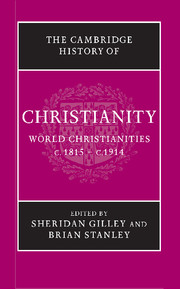Book contents
- Frontmatter
- 1 Introduction
- PART I CHRISTIANITY AND MODERNITY
- PART II THE CHURCHES AND NATIONAL IDENTITIES
- PART III THE EXPANSION OF CHRISTIANITY
- 26 African-American Christianity
- 27 Christian missions, antislavery and the claims of humanity, c.1813–1873
- 28 The Middle East: western missions and the Eastern churches, Islam and Judaism
- 29 Christians and religious traditions in the Indian empire
- 30 Christianity in East Asia: China, Korea and Japan
- 31 Christianity in Indochina
- 32 Christianity as church and story and the birth of the Filipino nation in the nineteenth century
- 33 Christianity in Australasia and the Pacific
- 34 Missions and empire, c.1873–1914
- 35 Ethiopianism and the roots of modern African Christianity
- 36 The outlook for Christianity in 1914
- Select General Bibliography
- Chapter Bibliography
- Index
- References
26 - African-American Christianity
from PART III - THE EXPANSION OF CHRISTIANITY
Published online by Cambridge University Press: 28 March 2008
- Frontmatter
- 1 Introduction
- PART I CHRISTIANITY AND MODERNITY
- PART II THE CHURCHES AND NATIONAL IDENTITIES
- PART III THE EXPANSION OF CHRISTIANITY
- 26 African-American Christianity
- 27 Christian missions, antislavery and the claims of humanity, c.1813–1873
- 28 The Middle East: western missions and the Eastern churches, Islam and Judaism
- 29 Christians and religious traditions in the Indian empire
- 30 Christianity in East Asia: China, Korea and Japan
- 31 Christianity in Indochina
- 32 Christianity as church and story and the birth of the Filipino nation in the nineteenth century
- 33 Christianity in Australasia and the Pacific
- 34 Missions and empire, c.1873–1914
- 35 Ethiopianism and the roots of modern African Christianity
- 36 The outlook for Christianity in 1914
- Select General Bibliography
- Chapter Bibliography
- Index
- References
Summary
The story of African-American Christianity is intimately entwined with the larger narrative of African-American history. In the late eighteenth and early nineteenth centuries Christianity became deeply rooted among people of African descent in North America and the Caribbean, and the black church emerged as the bedrock of African-American culture. In the years between the American Revolution and the Civil War, Afro-Christianity provided spiritual sustenance to many enslaved thousands in the American South while serving as the focal point of black community life and antislavery mobilisation in the North. After emancipation in both the South and the Caribbean, African-American congregations multiplied rapidly as millions of newly free people found an anchor in the church. In the USA, the black church was a locus for domestic and overseas missions, for protest against discrimination and violence, for black nationalism, and for debate over the relationship of African Americans to a dominant white culture that considered them second-class citizens. ‘The study of Negro religion’, concluded W. E. B. DuBois in The souls of black folk in 1903, ‘is not only a vital part of the history of the Negro in America, but no uninteresting part of American history.’
By the early nineteenth century, Christianity was just becoming entrenched in African-American society. Fuelled by evangelical revivals, Protestantism had made strong inroads among the enslaved and free black populations of colonial British North America and the West Indies during the second half of the eighteenth century. In many denominations from Georgia to New England, black and white Christians worshipped together in interracial congregations, and a growing number of white evangelicals believed slavery to be incompatible with the Bible.
- Type
- Chapter
- Information
- The Cambridge History of Christianity , pp. 427 - 442Publisher: Cambridge University PressPrint publication year: 2005

